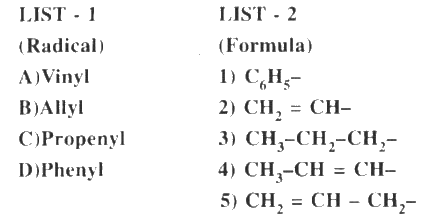What is the percent composition of a mixture of (S)−(+)−2− butanol, [±]25D=+13.520, and (R)−(−)−2− butanol, [±]25D=−13.520, with a specific rotation [±]25D=+6.760?Solution in Telugu
75%(R) 25%(S)
25%(R) 75%(S)
50%(R) 50%(S)
67%(R) 33%(S)
The correct Answer is:A
75%(R)25%(S)
Topper's Solved these Questions
- ISOMERISM BOOK - AAKASH SERIESCHAPTER - ISOMERISM EXERCISE - LECTURE SHEET EXERCISE-III (Stereo Isomerism) LEVEL-II (ADVANCED) More than one correct answer Type Questions
3 Videos
- ISOMERISM BOOK - AAKASH SERIESCHAPTER - ISOMERISM EXERCISE - LECTURE SHEET EXERCISE-III (Stereo Isomerism) LEVEL-II (ADVANCED) Linked Comprehension Type Questions
3 Videos
- ISOMERISM BOOK - AAKASH SERIESCHAPTER - ISOMERISM EXERCISE - LECTURE SHEET EXERCISE-III (Stereo Isomerism) LEVEL-I (MAIN) Straight Objective Type Questions
10 Videos
- IONIC EQUILIBRIUM BOOK - AAKASH SERIESCHAPTER - IONIC EQUILIBRIUM EXERCISE - ADDITIONAL PRACTICE EXERCISE (LEVEL -II PRACTICE SHEET (ADVANCED) (Integer Type Questions))
8 Videos
- PERIODIC CLASSIFICATIONBOOK - AAKASH SERIESCHAPTER - PERIODIC CLASSIFICATIONEXERCISE - OBJECTIVE EXERCISE - 3 (RECENT AIPMT/NEET QUESTIONS)
14 Videos
Similar Questions

The correct match is
View SolutionCompounds having the same molecular formula, same structure with different configuration are called stereoisomers and the phenomenon is called stereoisomerism. The phenomenon is broadly classified with three types called (a) geometrical isomerism (b) optical isomerism and (c) conformational isomerism.
Which of the following compounds exhibit both geometrical as well as optical isomerism
View SolutionWhich species does not exhibit a plane of symmertry ?
View SolutionA certain weak acid has Ka,=10−5. If the equilibrium constant for is its reaction with a strong base is repesented as y×10y then find the value of y.
View SolutionWhich one of the following orders is not in accordance with the property stated against it?
View Solutioncosα is a root of the equation 25x2+5x−12=0,−1<x<0, then the value of sin2α is: a.24/25 b. −12/25 c. −24/25 d. 20/25
View SolutionIf a=25, then a(25)0+a025= (a)25 (b) 26 (c)24 (d) 0
View Solutionif 25∑r=0.50Cr(.50−rC25−r)=k(.50C25), then k equals: (a) 225 (b) 225−1 (c) 224 (d) 252
View SolutionDextrororatory bytan−2−ol has a specific rotation [α]25D=+13.52∘. A sample of butan−2−ol shows a specific rotation [α]25D=+6.72∘. Calculate the enantiomers excess (or optical purity) of the sample?
View SolutionE_(H^(+)//H_(2))^(0)=0.00V, then E_(D^(+)//D_(2))^(0) at 25^(@)C will be
View SolutionPure (S)-2-butanol has a specific rotation of +13.52 degrees. A sample of 2-butanol prepared in the lab and purified by disillation has a calculated specific rotation of + 6.76 degrees. What can you conclude about the composition ?
View SolutionThe enantiomeric excess and observed rotation of a mixture containing 6 gm of (+)-2-butanol and 4 gm of (-)-2-butanol are respectively (if the specific rotation of enantiomerically pure (+)-2-butanol is +13.5 unit).
View SolutionIf a=25, then a(25)0+a025=
(a)25
(b) 26
(c)24
(d) 0
View Solutionif 25∑r=0.50Cr(.50−rC25−r)=k(.50C25), then k equals: (a) 225 (b) 225−1 (c) 224 (d) 252
View SolutionPure (S) -2- butanol has a specific rotation of + 13.52 degree. A sample of 2-butanol prepared in the lab and purified by distillation has a calculated specific rotation of +6.67 degrees. What can you conclude about the composition ?
View Solution
